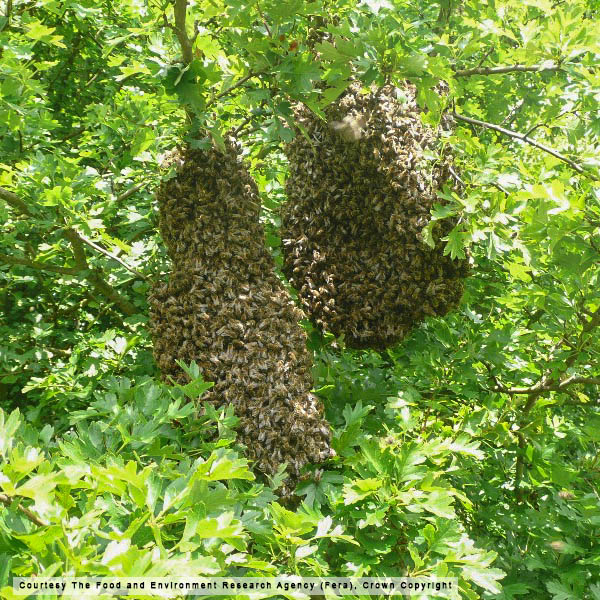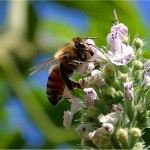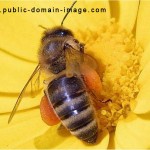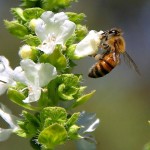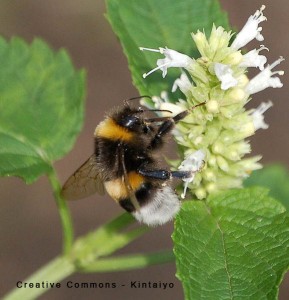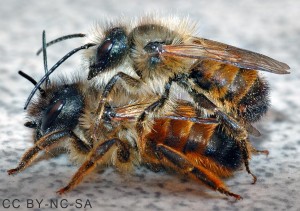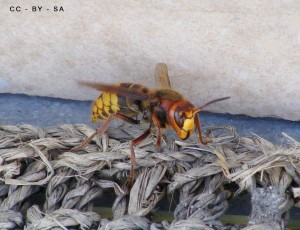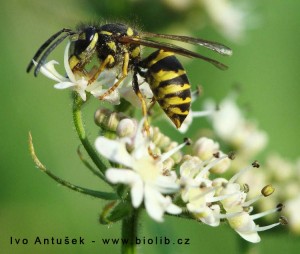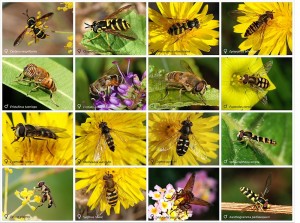Swarm Identification and Collection
The HWBKA has a team of competent beekeepers prepared to collect swarms in the local area. If you have noticed a swarm of honey bees, they should be collected as soon as possible. Swarms usually settle for a while in a cluster on a branch of a tree or similar location before moving off to make a new home. This could be in a cavity wall of a house, a chimney, or some other inconvenient place – it’s much better to collect the swarm before it moves off. The collected swarm will be re-housed in a beehive. Swarming happens from April to October but mostly in May and June.
Swarm Contact Details
- Phone: 07854 092 228 to arrange for a swarm collection. This line is manned by volunteers so you may not get through immediately at busy times.
- swarm@hwbka.co.uk (general enquiries only )
We can collect honey bee swarms only. We are not trained or insured to remove bumble bees and wasps etc. If you are at all unsure please check the pictures and descriptions below:
Charges: There is no charge for this service, and our members are unpaid volunteers. Donations are gratefully accepted and will help support bee education in schools and a bee research project at Royal Holloway College. HWBKA is a registered charity and gift aid is possible.
- Sort Code: 08-92-99
- Account Number: 65676220
- Account Name: HWBKA
- Reference of DONATION-SWARM)
Collection Area: We normally collect swarms in the High Wycombe area shown on the map. If you are outside this area it is better that you contact one of the other swarm collection services below:
- High Wycombe & District – swarm@hwbka.co.uk Tel: 07854 092228
- Mid Bucks BKA
- South Oxon BKA – southchilterns.bees@btinternet.com
- Chalfonts BKA – www.chalfontsbeekeepers.co.uk/ Tel: 0700 39 00 403
- Slough and Windsor BKA – slough-windsor-maidenhead Tel: 01753 642656
Swarm Identification:
We can help with honey bee swarms only – If you are unsure, please read the following information:
Honey Bees
A honey bee swarm is a perfectly natural event and is the way that honey bees reproduce. Thousands of bees will leave a nest or hive and when in flight will darken the sky. They can land anywhere (branch of a tree, fence, wall, roof of a shed etc), but once they have landed, they will often form a football sized pear shaped mass (see picture at top of page). This is a temporary stopping place while they look for a new home, and is the best time to for a beekeeper to collect them. They may stay for a few days or just a few hours before moving off.
It is therefore most important that you report the swarm as quickly as possible, allowing time for a bee keeper to attend site and remove the swarm.
PLEASE NOTE:
- Unfortunately we cannot collect bees that are established inside a tree, building or similar structure as they are very difficult to remove and may require cutting into the structure. We are not trained or insured for this. In many circumstances where bees have set up home inside a structure, the only solution is to employ a specialist company or destruction by registered pest control.
- We will do our best to respond to a swarm report in a timely manner, but this is a volunteer service and relies upon the availability of collectors.
Bumble and solitary bees:
TOP – Bumble Bee: During the summer our gardens are full of bumblebees which come in a wide range of colours and sizes. Unless provoked they will take no interest in people, simply intent on getting on with their pollinating and nectar gathering role. If you discover a colony of bumble bees (typically in an old bird box, behind a fascia board, in a hole in the ground etc), they should be enjoyed and it is best to let them get on with their lives.
If the colony is causing a real nuisance, bumble bee colonies can sometimes be moved to a new location,
Please click HERE to download an information sheet detailing how to deal with Bumblebees
BOTTOM – Red Mason Bee: Unlike honey bees or bumblebees, Red Mason bees are solitary. Solitary bees produce neither honey nor beeswax. Red Mason Bees like to nest in narrow holes or tubes, typically naturally occurring tubular cavities. Most commonly this means hollow twigs, but sometimes abandoned nests of wood-boring beetles or carpenter bees,small holes in walls or even snail shells.
Hornets:
Hornets are large (30 to 40mm), noisy, wasp like insects, that live in small colonies.
They can look and sound quite intimidating, but they are rare, do no harm and should be left alone.
Wasps:
Wasps (15 to 20mm long) can be a real nuisance, and tend to appear in greater numbers later in the year when their social structure starts to break down. Wasps can typically form colonies underground, behind fascia boards or in roof spaces. When their nest can be seen it will usually resemble a football sized ball made of a papery material. The High Wycombe District Council have a pest control service and details of their service can be found at http://www.wycombe.gov.uk/council-services/environment/pest-control.aspx
Flies:
These smaller insects – hover flies – are completely harmess.
Often seen hovering or probing flowers along side bees. They too have banded bodies, but on examination are quite different to bees.

